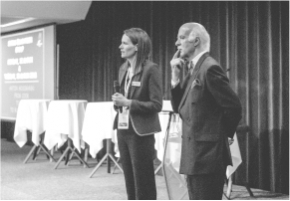- About
- Programs
- Innovation & Research
- Campus Life
- Career Services
- Admissions
- News & Events
- Alumni
Rise, Lead, Inspire: How to Become a Female Leader Today
Learn how to become a female leader with clear steps, tools, and real stories. Start your leadership journey today—your path to impact begins here.
Key Takeaways
- Women in leadership often face both structural barriers and subtle biases that undermine their visibility and credibility.
- Strong female leaders develop key skills, stay visible, and lead with clarity, confidence, and a commitment to growth.
- When women hold leadership roles, they help shift norms, serve as role models, and open doors for other women to rise.
For the majority of history, women weren't kept out of leadership roles because they weren't capable; rather, they were prevented from entering at all. Decisions were made behind closed doors, and women stood on the other side, their insights left unspoken and their potential untapped. Thankfully, that's changing.
Today, more women are stepping into leadership roles, not quietly or cautiously, but with clarity, vision, resilience, adaptability, and strength. There is a growing recognition of the value they bring when given the space to lead.
Understanding how to become a female leader in today's world means learning to trust your own voice, challenging outdated norms, navigating systems that weren't always built for you, and helping reshape those systems for the ones who come next.
Challenges Women Face in Leadership
Despite progress, many challenges still stand in the way of women advancing into leadership roles. However, these barriers are no longer necessarily codified in laws or company policies. Instead, they're often structural, cultural, relational, psychological, and deeply embedded in the way organizations function and leadership is imagined.
These challenges rarely stand alone. Women often face a cluster of pressures at once. Studies suggest that many women face ongoing struggles with work-life balance, subtle and overt forms of sexism, limited recognition among peers, and a constant need to prove themselves, even after proven success.
Feelings of self-doubt are common, not because of a lack of ability but because the environment makes it harder to feel seen and supported. In many cases, the possibility of becoming a mother adds another layer of pressure, influencing how others perceive a woman’s long-term potential or commitment to her career.
When it comes to representation in politics, for example, as of 2025, UN Women reports that women serve as Heads of State or Government in just 27 countries. Cabinet-level roles remain largely male-dominated, with women holding only 22.9% of ministerial positions leading policy areas. In parliaments, only six countries have reached gender parity. At the current pace, global equality in political leadership is more than a century away. The gap in the private sector, particularly in top corporate roles, is even more pronounced.
While more women are entering vice-president-level roles, the C-suite (senior executives in an organization) remains out of reach for many, and it's not due to a lack of skill or ambition but due to systemic patterns that continue to favor men in core decision-making roles.
One of the most studied of these patterns is the “broken rung.” It refers to the very first step into management, where women are often passed over for promotions, particularly in roles with profit-and-loss responsibility. Research suggests that women are less likely to apply for these early leadership positions, not because they don't want to lead but because the roles are often shaped around values and behaviors women are taught to avoid. It's not about ability. It's about assumptions.
Even when women do step into leadership, the odds can still be stacked against them. The “glass cliff” describes a pattern where women are more likely to be offered top roles during times of crisis (when companies are struggling or reputations are fragile). In these moments, decision-makers often associate feminine-coded traits like collaboration and communication with the ability to calm things down. While these appointments can be empowering, they also place women in riskier positions where stability is harder to achieve and scrutiny is higher.
Although women now hold 29% of C-suite roles—up from 17% in 2015—this progress has been uneven and fragile. A significant share of these gains came not from promotion into core operational roles but from the expansion of staff functions such as HR, legal, and IT, where women are more commonly hired. While these functions are important, they rarely serve as direct pipelines to CEO positions.
Since companies can't keep inventing new roles, this strategy is not sustainable. Therefore, even the progress of recent years in its current form is fragile.
Being aware of these barriers matters, especially for women preparing to lead in global industries. At César Ritz Colleges, students learn how to manage events, projects, and people. They're trained to recognize the context and forces that influence leadership opportunities, including bias, role access, and leadership culture.
If women are to lead on equal footing, it's not enough to open the door. The structure inside has to be examined, too. This is where the three Rs (Rethink, Refine, Realize) taught at César Ritz Colleges come into play. Changing the game and setting new standards is the DNA of a César Ritz Colleges education, and this mindset is crucial for advancing women in leadership.
How to Become a Leader: A Guide for Women
Though the challenges women face in leadership are distinct, so are the qualities they bring to the table. Resilience, emotional intelligence, cultural sensitivity, clear communication, and the ability to build trust within teams are traits commonly associated with women, and they are all leadership assets.
Research increasingly confirms that when women lead, results follow. In a 2023 analysis, women were rated higher in overall leadership effectiveness and creative leadership competencies across the board. It's also reported that they tend to rely less on reactive behaviors, making their leadership more intentional and adaptive compared to their male counterparts.
Your Leadership Journey Starts Here
Master the art of hospitality management
The path to becoming a leader is an ongoing process that begins with clarifying what matters to you and building skills that match your vision.
Clarify your leadership vision
Leadership, regardless of gender, starts with a sense of purpose. Before you manage others, it helps to understand what kind of manager or leader you want to be. That means stepping back to define your values and the kind of impact you want to make.
One way to do this is by writing a personal leadership vision or mission statement. This short statement can serve as your compass and help you make decisions as well as stay grounded in what it all means to you.
For many women, this includes a strong focus on empathy, collaboration, active listening, inclusive decision-making, and trust-building.
Build core leadership skills
A title might get you through the door, but it's your ability to lead well that determines whether you stay there and where you go next.
The most effective leaders are usually strong in four key areas: strategic thinking, communication, decision-making, and team management. These aren't fixed traits; they can be learned through intentional learning and consistent practice.
For many women, leadership growth starts with reclaiming the very qualities they've been told to "downplay". Active listening, emotional insight, cultural awareness, steady communication, team cohesion, conflict resolution, empathy under pressure, boundary-setting, and the ability to read group dynamics are consistently linked with higher engagement and stronger collaboration.
In industries like hospitality, where every day involves managing people and thinking on your feet, these skills are foundational. At César Ritz Colleges, leadership development is integrated into every aspect of the curriculum. Students study strategic planning and team dynamics, but more importantly, they live them by managing real-world projects and learning to lead teams.
Cultivate visibility and influence
Many women hesitate to showcase their accomplishments. Confidence that is praised in men can be questioned in women, sometimes seen as arrogance or self-promotion. This difference in perception has a cost. When work isn't acknowledged, contributions are overlooked, and leadership potential remains unseen.
At César Ritz Colleges, visibility is part of how students learn to lead. Through projects and professional engagement, students are encouraged to take initiative, contribute their perspectives, collaborate with peers, and apply effective leadership in real settings. Each action reinforces your role as someone who brings value and moves things forward.
Visibility also helps others connect your name with impact. When colleagues and decision-makers regularly see you contribute, it becomes easier for them to picture you in more senior roles and include you in key conversations.
Find and leverage mentorship
Leadership is never a solo climb. Every strong leader needs a web of support, with mentorship often being at the center of it. For women, mentorship can be especially powerful, particularly when it comes to navigating the unwritten rules that influence who advances and how.
Some hesitate to seek mentorship, assuming they need more experience before asking for guidance. In reality, the earlier you start, the more you gain. Look for mentors through alumni networks, employee resource groups (ERGs), leadership programs, or even former supervisors whose leadership style you respect.
At César Ritz Colleges, mentorship is part of a broader network of support that includes direct access to industry professionals. Through the International Recruitment Forum, students connect with over 100 recruiters from global hotel groups, cruise lines, financial services, event companies, and more.
These interactions go beyond interviews. They provide insight into industry expectations, sharpen communication skills, and give students a clearer sense of where their studies can take them. Whether through formal advising, professional exchanges, or candid conversations at IRF, students gain the confidence to take initiative and build their leadership path early.
Finding the right mentor won't guarantee a leadership role, but it will make the path clearer and far less isolating.
Navigate and overcome challenges
In addition to the larger obstacles women face in leadership, everyday moments can carry just as much weight. Interruptions, being spoken over, being dismissed without acknowledgment, or being quietly left out of key decisions are situations that women tend to experience more often, especially in male-dominated environments.
"Mansplaining" a colloquialism on the rise, is another common occurrence in the workplace–when a man provides an unsolicited explanation based on the assumption that a woman wouldn't already possess the knowledge. This behavior initially can be perceived as friendly and helpful, but over time, it creates strain and subtly undermines confidence and credibility. Responding to this behavior doesn't always have to be confrontational. Often, redirecting the conversation or calmly returning to your point is enough.
Peer amplification is another useful strategy for women in the workplace. It is a practice where women intentionally echo and credit each other's ideas, which helps ensure contributions are heard and properly recognized by colleagues and management.
Leadership will always come with challenges. The important thing is to learn how to navigate them without losing your ground.
Build and lead strong teams
Leadership doesn’t happen in isolation; it takes shape through relationships, trust, consistency, and shared purpose. The most effective leaders understand that success depends on the strength of the team, not just individual performance. What helps hold those pieces together are the qualities often associated with women, such as empathy, emotional awareness, steady communication, patience, and active listening.
These traits support something every team needs: psychological safety. When people feel comfortable asking questions, offering feedback, raising concerns, or admitting uncertainty, they become more engaged and more willing to contribute to the team.
At César Ritz Colleges, we teach students to lead with presence, not pressure. They're encouraged to create space for others to contribute and to understand that leadership isn't about having every answer but about helping the best answers surface.
Evolve with the role
The most successful women leaders understand that growth doesn't end once they reach a position of influence. In many cases, that's when it truly begins.
As teams expand, industries change, expectations rise, and new challenges emerge, leadership must keep pace. What worked before may no longer fit the moment. The leaders who adapt are the ones who seek feedback, adjust their approach, welcome discomfort, and stay curious.
We encourage our students to see leadership as a long-term process that requires hands-on learning, direct engagement with real-world challenges, thoughtful mentoring, and ongoing reflection. Only this way can they develop the needed leadership mindset.
Female Leaders Who’ve Paved the Way
Interestingly, the trend of the glass ceiling tends to weaken in companies with a history of female leadership, as companies that promote women tend to see increased profitability. This suggests that representation reflects progress as well as helps create it.
For example, a Credit Suisse report showed that female CEOs are significantly more likely to support other women into leadership. Specifically, companies led by women are 50% more likely to have a female CFO and 55% more likely to have women leading business units.
What this means is that the benefits of having women in top roles extend beyond symbolism. They create a self-reinforcing environment where more women are developed, promoted, and retained—making it more feasible to break that ceiling and build lasting change.
Marie Louise Ritz, an influential figure in luxury hospitality, transformed the vision of César Ritz into a lasting legacy after her husband's death.
As a woman operating in a patriarchal world, she faced skepticism about her ability to manage the business side of the Ritz brand. Yet, she navigated it with precision and diplomacy, safeguarding the reputation of Ritz hotels while expanding their influence. Her stewardship of the brand helped embed service excellence into the hospitality model we recognize today.
Indra Nooyi, former CEO of PepsiCo, pushed long-term sustainability before it became mainstream. Her “Performance with Purpose” strategy balanced business growth with health and environmental goals. As a woman of color leading a global company, she faced resistance but earned respect by grounding bold ideas in clear business logic.
Jacinda Ardern, former Prime Minister of New Zealand, led with empathy during crises like the Christchurch shootings and the COVID-19 pandemic. Often labeled "too soft" or "too young," she redefined leadership by proving that compassion and decisiveness can go hand in hand.
Whitney Wolfe Herd, founder and CEO of Bumble, disrupted the tech and dating industry by creating a platform where women make the first move. After leaving Tinder and filing a widely reported harassment and discrimination lawsuit, she launched a competing company built around values of respect and control. Her decision to put women in charge was a direct response to power imbalances in spaces where they'd often been sidelined.
Each of these women changed more than their industries. They challenged the idea that leadership must look or sound a certain way. And in doing so, they made space for others to rise behind them.
Tips to Stay Motivated and Resilient
Motivation fades. Criticism can be hard to hear. Setbacks are inevitable. What matters most is how you respond when these challenges begin to pile up.
For women in leadership, especially in spaces still dominated by outdated thinking, staying resilient is a daily practice rather than a mindset you switch on once. The following strategies can help you stay focused and steady even when things get difficult:
- Build a system, not a mood.
Motivation isn’t always dependable. Routines, however, can carry you through low-energy days. Regular planning, personal check-ins, goal tracking, time blocking, and small rewards for progress can help you stay steady when motivation dips.
- Treat feedback like a filter, not a mirror.
Not every opinion needs to shape your self-image. Ask yourself: Is this feedback specific? Is it constructive? Is it coming from someone whose leadership I respect? If the answer is no, acknowledge it and move on.
- Don’t wait to be invited.
Sexism still lingers, especially in older leadership structures where being underestimated can feel routine. If the space isn't offered, take it. Speak first. Put your name forward. People may not expect you to lead, which is exactly why you should.
- Stay focused on the future.
One bad meeting, one setback, and one quiet week don't erase your path. Keep your attention on what you're building and treat challenges as part of the process.
Your Leadership Is Yours to Define
Women have always had the potential to lead. What's changed is access—the increasing number of spaces where that potential is recognized, supported, encouraged, and given room to grow. Education is one of those spaces. For many women today, it's also one of the most powerful tools for creating the future they want.
At César Ritz Colleges, we understand what it means to build something with lasting impact. The Ritz name stands for excellence and innovation, carried forward by two entrepreneurs. César Ritz redefined hospitality, and Marie Louise Ritz preserved and evolved that legacy through determined leadership at a time when few women were seen in such roles. Their combined vision continues to inspire how we think about leadership today.
In that spirit, we believe in women's ability to influence change and define success on their own terms. Our Master of Science in Leadership program is here to support that ambition. The opportunities are real. The environment is ready. What comes next is yours to decide.
Frequently Asked Questions
What industries have the most female leaders?
Utilities and health care have some of the highest shares of female leadership.
How long does it take to become a leader?
It varies based on your industry, experience, and the opportunities available. Leadership often begins when you take initiative and earn the trust of others.
Can introverts become effective leaders?
Definitely, introverts often excel in leadership through their listening skills, thoughtful decision-making, calm presence, and strong one-on-one communication.
Are you wondering where to start your dream hospitality career? Look no further than a bachelor’s degree at César Ritz Colleges Switzerland.





















